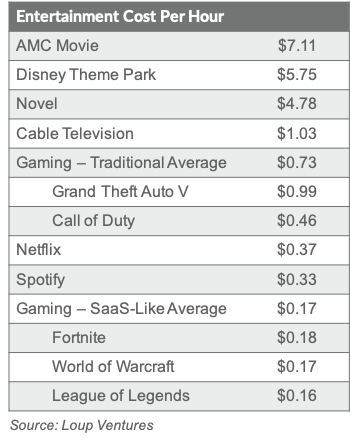Free-to-play games with SaaS-like models offer the least expensive form of entertainment available today. Not only does gaming offer the lowest cost per hour, but it also provides a highly dynamic set of experiences.
In our most recent study, we quantified the cost per hour of various forms of entertainment. For subscription-based entertainment, we used the monthly subscription price and compared it to the average number of hours per month per user spent on the platform. For non-subscription businesses like a Disney theme park or any of the games on the list, we calculated average revenue per user (ARPU) before looking at the average hours spent on any form of entertainment.
A few takeaways:

SaaS-like gaming offers the cheapest forms of entertainment
Fortnite and League of Legends rank among the cheapest forms of entertainment. While not a free-to-play game, World of Warcraft monetizes at a similar rate to the free-to-play games, as it is offered on a subscription basis. Those three titles average $0.17 per hour in monetization (i.e., players effectively pay $0.17 per hour they spend playing the game). Each of those titles offers low barriers to start playing and consistently iterate on the existing product with new experiences to keep customers engaged, much like good SaaS products.
More traditional games, like GTA and Call of Duty, monetize at much higher hourly rates than SaaS-like games, and they need to given the differences in their models for updating content. We think of traditional games as those that charge a set price up front for the game regardless of after-purchase monetization. Call of Duty launches a new game every year, and GTA launches a new game every five to seven years. These titles sell a new $60 game every year or every few years with some modest incremental content in-between.
As games increasingly become the next social networks, the SaaS-like model makes more sense to achieve greater distribution, enhancing the network and maximizing long-term monetization even if the per hour rates remain below traditional rates.
Gaming is highly dynamic and offers a near-infinite number of unique experiences
Massively scalable and dynamic game worlds enable a far lower per-hour cost than other forms of entertainment. While the core gameplay of Fortnite remains the same, players are free to drop wherever they choose in each instance of the game. The randomized weapons they discover, the opponents they face, and the storm circle are different each time. Unique gameplay experience keeps players coming back for more.
Compared to other forms of entertainment, like movie theaters, theme parks, novels, or Netflix, the ability to provide a unique experience is more difficult. A novel doesn’t change the next time someone reads it. For a theme park to provide a new experience to guests, a massive undertaking is required to create that experience, both financially and temporally. Even Netflix struggles with keeping content experiences fresh. It’s hard to surprise viewers of a movie or film since most stories are just versions of something similar told in the past. Netflix makes up for this with a large volume of content, which they’re required to constantly refresh.
Gaming doesn’t have to refresh content to the same extent, as it is the nature of games to provide a unique experience every time. In addition, it’s much more cost-effective and easier to deploy new content. Game patches can be built without disrupting gameplay and be delivered digitally to players. For almost every other type of entertainment on the list, content expansion is a significant undertaking.
Ultimately, the relatively low hourly cost of SaaS-like gaming gives titles like Fortnite and League of Legends an advantage when it comes to building a massive, long-term audience. We don’t expect these franchises to try to bring their hourly monetization up to the level of traditional games, but we do expect them to build beyond mid-teens as gamers are likely to be willing to pay more provided there are value-add experiences they can purchase.
The bigger opportunity for SaaS-like, free-to-play games lies in optionality around building a digital third place for their audiences where people socialize with their friends and share experiences like concerts or even movies. Games are the future of social and the best chance at creating a metaverse with unknowable monetization potential.
